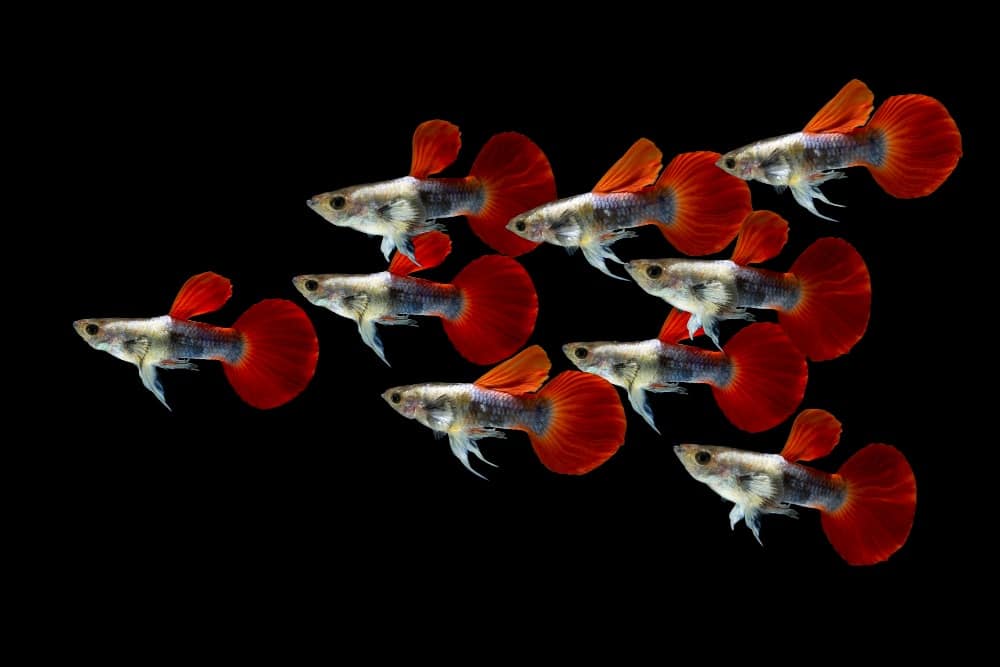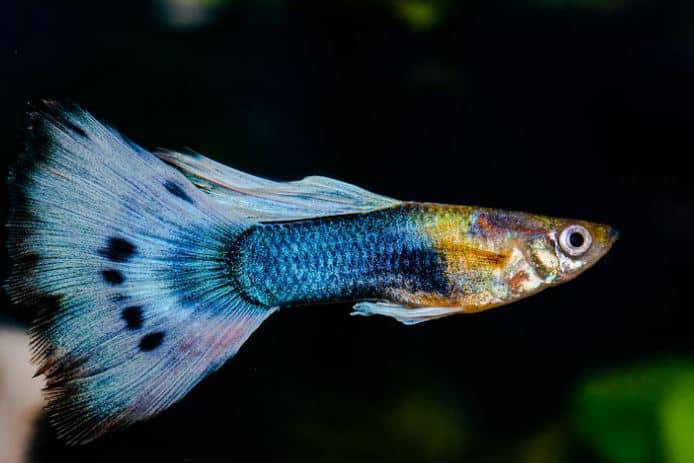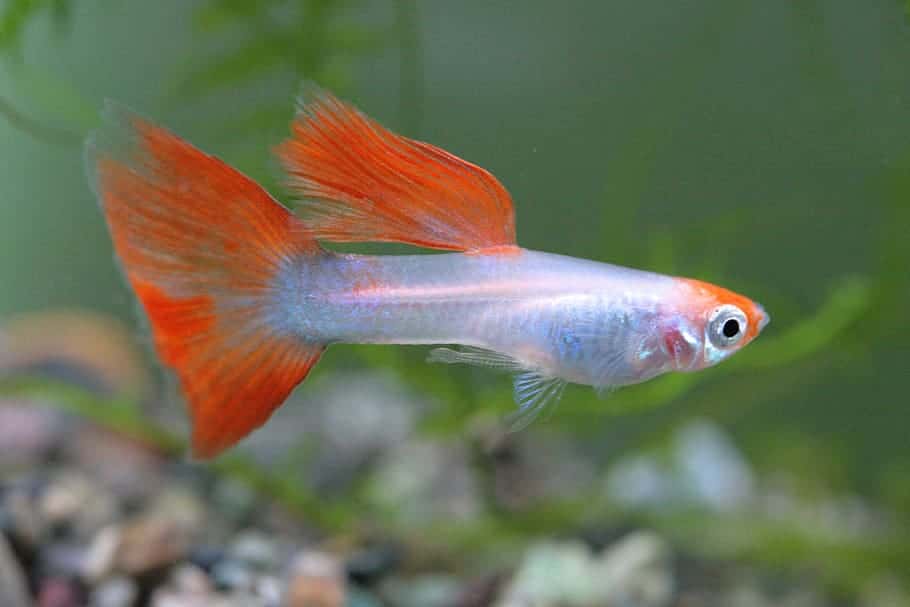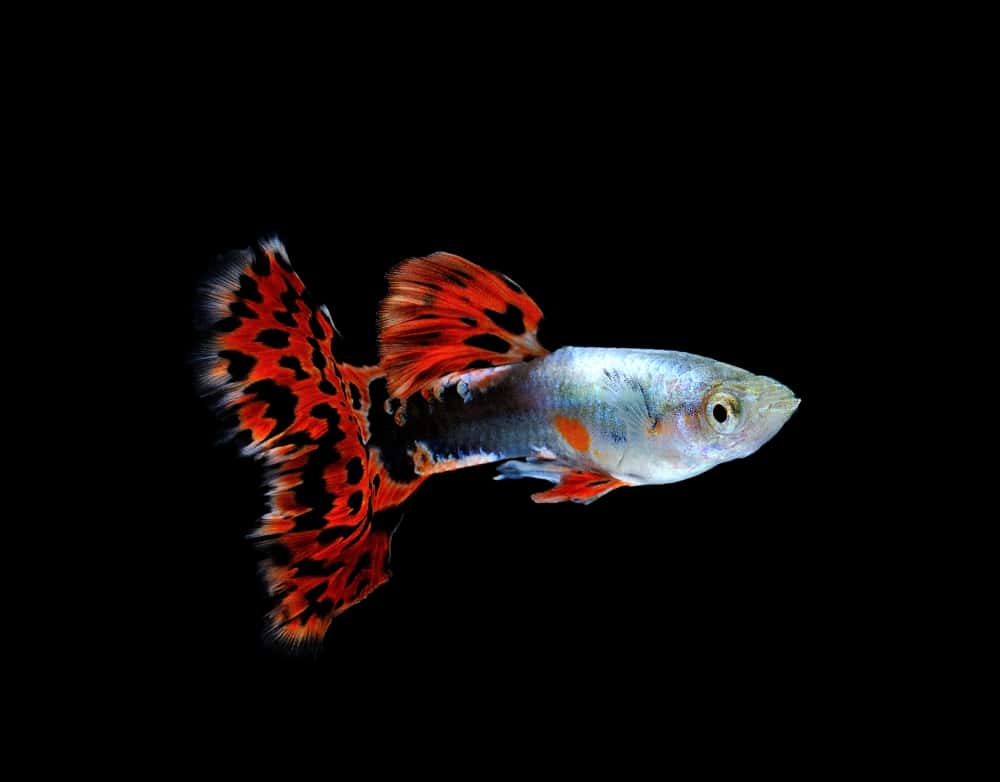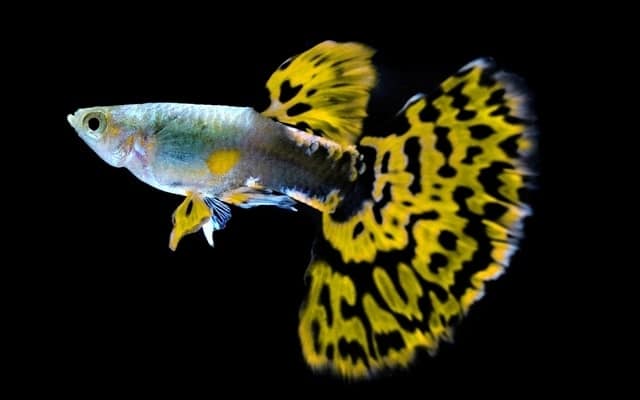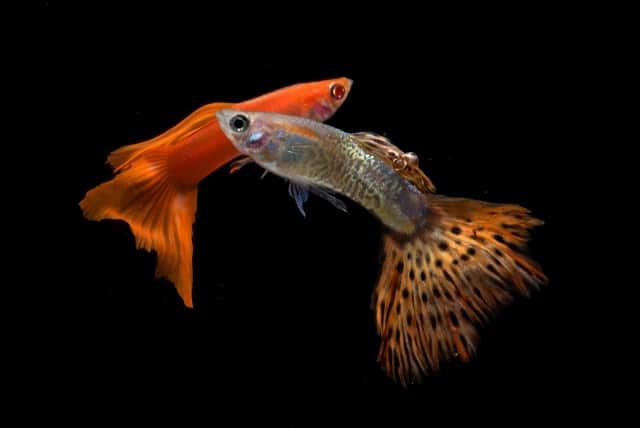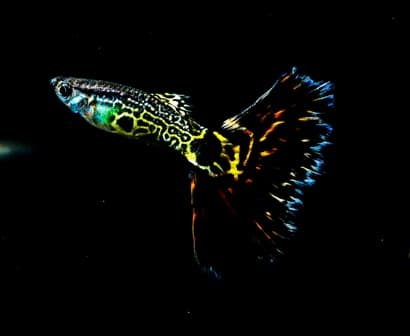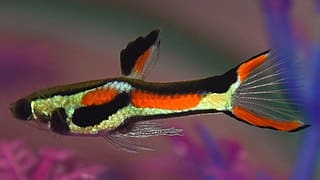Valuable Guppy Care Information, Includes 21 Pictures
By Don Glasgow & Jino S
Guppy Care
There used to be a boring, who cares, introduction paragraph here. I’ve updated the article and deleted that paragraph.
I’ve made it simple: “Now for a fish who needs no introduction, GUPPY!”
That was simple. Moving on to the good stuff…
Taxonomy
Tax-o what?? Oh for goodness sake, speak in plain English. I’m an important man, and I have a lot of important things to do, and they don’t include looking up words in the dictionary!
Species name: Poecilia reticulata. (Again? Really? Porta what?. Just use the word guppy if that’s what you mean.)
Below: A bunch of scientific names you didn’t come here to read. I think you wanted to learn about guppies, not take a spelling test, so do yourself a favor and skip ’em.
Genus: Poecilia.
Family: Poeciliidae.
Order: Cyprinodontiformes.
Class: Actinopterygii.
There was a bunch of scientific information about guppies here that I deleted (sorry Google). If you need to read scientific stuff about guppies, visit Wikipedia.
Love scientific stuff? Here’s a PDF about guppies. It taught me that guppies have teeth!
Description of the guppy fish
Poecilia reticulata is most commonly known as guppy fish, but guppies also answer to many other names (like Fred and Joe and Bertha. Actually, I just can’t see a guppy answering to any name), including “million fish” and “rainbow fish.”
Wild guppies have spots of color here and there on their bodies (mostly males). Guppy breeders took advantage of this, and now you have many amazing guppy colors that are available.
Sexual dimorphism in guppy care
Di-Morph what? Ok, there ya go again. More scientific made-up words. For the rest of us, “How do you tell the difference between a male guppy and a female guppy?”
This is pretty easy. Female guppies are usually 2 to 3 times larger than the males. Their bodies are also rounder than the males.
Wild male guppies feature colorful spots and are relatively small in size. Maybe an inch long. Cultivated male guppies, sold for their colors, may be as large as 2 inches, including the tail.
General appearance
Guppies look like, well…a small fish.
Here is a female guppy. Kinda fishy looking, huh?
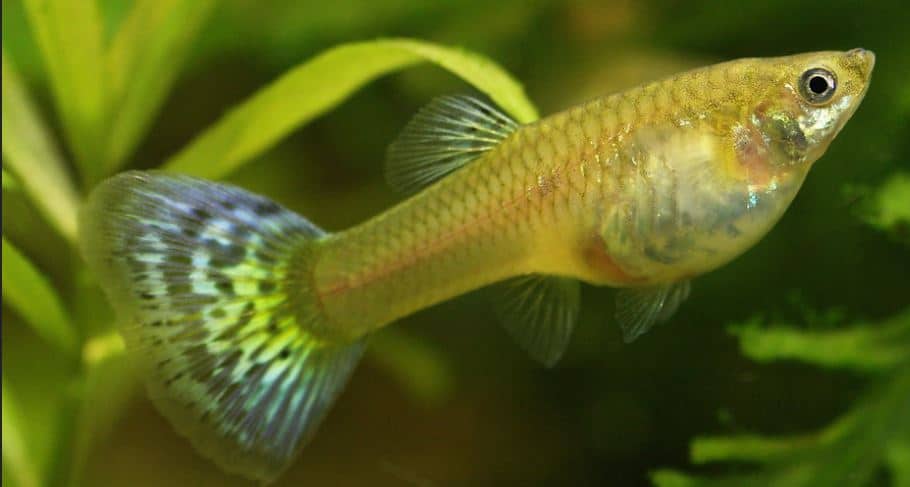
Here is a male guppy:
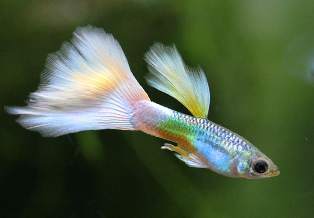
FYI: If you have too few females in a tank with too many males, the constant stress of the males attempting to breed the females may end up killing the female due to stress.
Coloration
Rather than talking about guppy coloration, here are some real-life examples:
Experience These Article in Audio Using Your Browser!
If a system or browser is not mentioned here, the I haven't been able to find out how to make the system or browser work to read aloud.
PC's: Using the Edge Browser, left click on the article text and scroll down to "Read Aloud." The article will automatically be read to you.
iPhone using the Edge Browser: Using the Edge brower, tap the icon that looks like a book with a speaker located in the in the address bar. The article will come up now showing 4 icons on top. Tap on the second icon from the right to have the article read to you.
Android phones: Google Assistant is the most convenient way. Say, "Google, read this page."
Images Below: Most of these pictures have a link to a large size image. Tap to view.
Distribution and Habitat
Guppies are freshwater fish found in clear, tropical waters across the Caribbean Islands and the North part of South America.
Humans have introduced guppies in many Asian and African countries to control the mosquito population. While this has helped reduce the spread of malaria and other diseases, guppies have also become an invasive species.
Guppies have many natural habitats but prefer freshwater ponds and streams near coastal areas. They can also thrive in brackish waters with a slight saline level. (Pre-salted guppies for the predators to enjoy).
Nonindigenous (Non-native) Aquatic Species – Guppies
Natural predators
Guppy predators are everywhere. Guppies school together to reduce the chances of being prey. In other words, maybe the predator will take a guppy from the outside of the group, leaving the guppies in the middle safe.
One guppy to another, “Sorry Joe, you pulled the short straw. You’re on the outside of the school today.” Humans have introduced guppies in many Asian and African countries to control the mosquito population. While this has helped reduce the spread of malaria and other diseases, guppies have also become an invasive species.
Guppies have many natural habitats but prefer freshwater ponds and streams near coastal areas. They can also thrive in brackish waters with a slight saline level. (Pre-salted guppies for the predators to enjoy).
Guppy Grass For Sale
Live plant that provides a place for baby guppies to hide. View current price on Amazon.
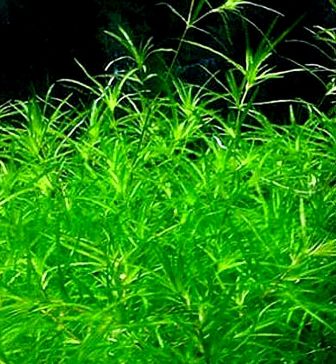
Tap this box to check the current Amazon price.
Guppy types available in the hobby
We identify guppies according to the varieties in four distinctive categories: color, pattern, tail pattern, and tail type.
Guppy body colors that are available:
Solid: These guppies have mostly one color on their bodies. Common colors are blue, yellow, red, black, and purple.
Uncommon colors include Vermilion, Burlywood, egg-shell white, and plaid.
Bi-color: Most guppies are bi-colored as seen in the posted pictures.
Albino: These guppies lack the black pigment, melanin, in their bodies, making them appear mostly pale white.
Metal: You can see metal colored guppies in the guppy line up below.
Guppies tail types: Some of the most popular tail types are triangle, fan, flag, needle, veil, sword, spear and round. The name describes the tail.
Blue Guppies For Sale:
You’re not gonna find this guppy color at your fish store.
Tap this box to check the Amazon Price.
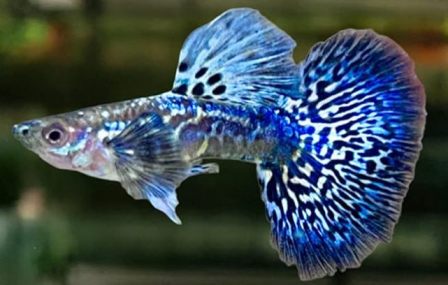
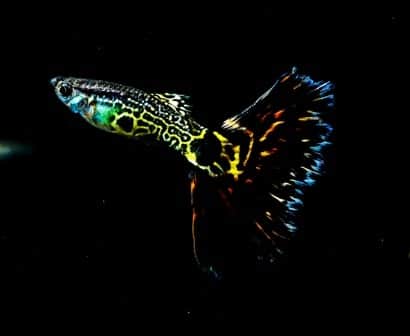
Metal Color Male Guppy
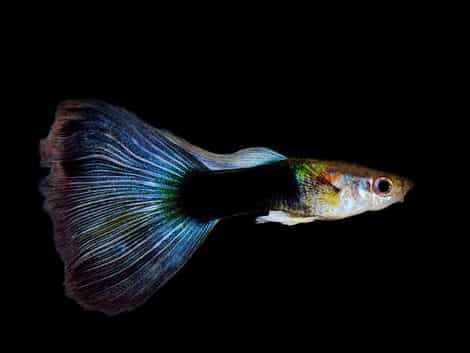
Bi-color Male Guppy
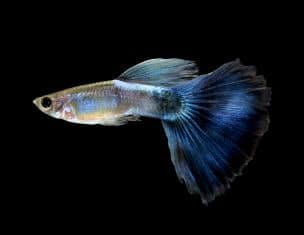
Solid Color Male Guppy
Lace: An elegant, delicate rosette pattern that is common on snakeskin guppies.
Mosaic: A spotting pattern that lacks a regular shape.
Leopard: Consists of a plethora of dark spots that resemble the pattern on a leopard’s fur.
Grass: Similar to the leopard pattern, but more delicate, with smaller spots.
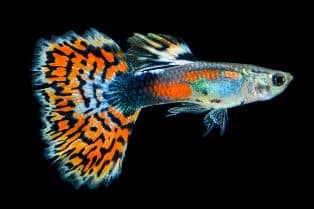
Lace Tail Male Guppy
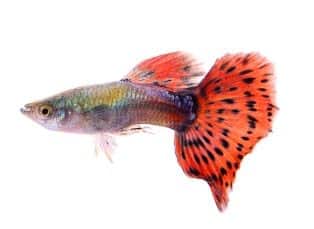
Leopard Tail Male Guppy
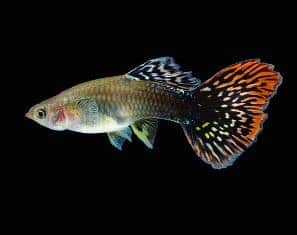
Mosaic Tail Male Guppy
Lifecycle and Guppy Care
Guppies are part of a fish group called livebearers because they do not lay eggs. Instead, the male fertilizes the eggs within the female and the female gives birth to fully formed fry.
After fertilization is complete, the eggs develop within the female guppy for around a month before she gives birth.
It takes guppy fry a month to grow to the juvenile stage, where they start developing their sexual characteristics and showing color. After another month, they will become young guppies and reach sexual maturity.
It takes young guppies an additional six months to mature completely, finishing their size growth and developing their final coloration.
Under proper conditions, guppies can live up to five years.
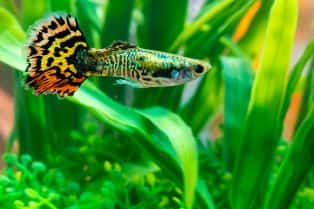
Setting Up The Guppy Aquarium
The bare minimum tank size is to provide one gallon per fish in a lightly stocked community tank.
Guppy tank reality from my experience: Given a couple of years a pair of guppies could fill a 10 gallon tank with so many guppies that there won’t be any room for water. This is the truth.
Water parameters
Guppies are well-known for being sturdy (kinda like my aunt Bertha) and not picky (aunt Bertha again) about their environment, but that doesn’t mean you shouldn’t be concerned about water parameters. These fish have nuanced (who uses this kind of language? I guess I do. Sorry.) needs and therefore prefer a particular type of water.
pH: Guppies and other types of livebearers prefer water that is a neutral pH between 7.0 and 8.0 is fine.
Water hardness: Despite their ability to thrive in most types of water, guppies prefer a hardness between 8 and 12 dGH, as higher levels usually involve an increase in pH.
Ammonia: Ammonia will kill any fish, guppies included. Ammonia test levels should be zero.
Nitrate: Through regular water changes and the inclusion of plants to the tank, nitrate levels should be close to zero. Despite this, guppies can withstand levels up to 40ppm. My 40 gallon tank stays at a constant 40 ppm nitrate level. It has a lot of plants in it and I change the water frequently. Nitrates don’t harm fish, so I don’t worry about it.
Filtration
Guppies are low-maintenance in all senses, meaning they don’t require a complicated filtration system.
When fed correctly, their waste levels are relatively low, so regular hanging filters should be enough to keep the aquarium clean, as long as the filter’s power is proportional to the size of the tank.
I am an over-kill person with filtration. I have two cannister filters on a 40 gallon tank. Overkill, but I’ll never have an ammonia spike.
Preferred substrates
When it comes to substrates, the best choice depends on the owner’s tastes. Guppies don’t care, so go with what you like.
Plants and decorations
I’ve read that guppies want places to hide in the aquarium, but I’ve never seen a guppy hiding.
If you want to indulge that idea, live plants are an ideal pick, but plastic plants are also a good choice.
Red Guppies For Sale:
You’re not gonna find this guppy color at your fish store.
Tap this box to check the Amazon Price.
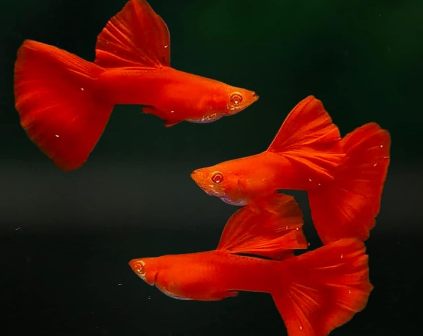
Guppy behavior and tank-mates
There were several paragraphs here about how peaceful guppies are. That was a waste of words. Here’s what you should know:
* Guppies are very peaceful fish.
* Don’t put guppies in tanks with large fish. I think you can figure out why. If you can’t figure out why, don’t buy guppies. Maybe a puppy would be more fitting.
* Don’t put guppies in with “fin nibblers.” I have Tiger Barbs and they are fin nibblers.
Guppy feeding and dietary requirements.
Guppies have a problem.
While they are small and have a tiny stomach that can’t fit much food, like all animals, they love to overeat.
It’s up to you to monitor how much they eat, so you must be careful. Ideally, guppies should be fed only twice a day, and the portions should consist of what they can eat within two minutes. Baby guppies should be continuously fed through the day, with smaller pieces and smaller portions.
Your best bet is to feed your guppies a mix of processed and live or frozen foods. Flakes and pellets provide the nutrients they require, while frozen or dried bloodworms, brine shrimp, or mosquito larvae provide protein and resemble their natural diet. (Yawn. What? Are we there yet?)
Since guppies are omnivorous, it’s also a good idea to feed them vegetables and fruits, preferably peeled peas, zucchini, or cucumbers. They also love spinach.
Common guppy diseases
Despite their delicate appearance, guppies are rather sturdy fish (Didn’t I talk about this before? Bertha and all that?) and are not prone to sickness. However, they are vulnerable to certain illnesses if exposed to parasites, bacteria, or ill-suited living conditions. They are also susceptible to stress which is something that makes them prone to disease.
The following are the most common diseases that affect guppies.
All of the following problems are caused by one of two issues:
* Poor aquarium maintenance: Aquarium keepers not taking good care of the guppies by doing frequent tank cleaning and having good filtration.
* The parasite Tetrahymena (#4). I use a UV sterilizers to try to keep this parasite under control. This treatment is only partially successful.
Ich:
Alongside the distinctive white spotting, Ich displays symptoms like reddening of the fins and behavioral changes, particularly a loss of appetite and frequent rubbing against the aquarium and its decoration.
There are many commercial drugs to treat Ich, usually including malachite green, formaldehyde, and copper sulfate. You will probably need to perform extensive water changes both before and after treatment.
Keep track of the aquarium’s water parameters, as Ich is frequently the consequence of fluctuations in the water’s temperature, pH, or low water quality (I.E. This is the fish keepers fault.)
Fin and tail rot:
As the name says, fin and tail rot involve a progressive damaging of the guppy’s fins and tail. It can appear as holes, white edges, or general torn injuries to the fins or tail.
Fin and tail rot is usually the result of a bacterial infection, a fungus, or even ammonia burn. While fin rot can happen if the water parameters of your tank are unfavorable, it can also occur through fin nipping from a more aggressive species.
Treatment for this disease depends on the root cause. In all circumstances, it’s best to separate the sick fish from the healthy ones and perform a complete change of water. Treat with commercial antibiotics if bacterial, or antifungal medication if appropriate.
Velvet:
Similar to Ich in appearance, Velvet is a highly contagious disease, identifiable thanks to the tiny, gold spots that cover the surface of the guppy’s skin and fins.
If left untreated, the gold spots give way to skin damage, heavy bleeding, and potential death. Fortunately, Velvet is curable if caught early, usually with commercial copper medication.
To achieve complete removal of Velvet after treating the sick guppy(s), perform a 90% water change once the fish are symptom-free.
Guppy Disease:
Aptly named, this disease attacks guppies far more frequently than any other species. It’s caused by protozoans from the Tetrahymena genus.
It displays symptoms similar to Ich, particularly the typical white spots. Alongside this, the sick fish will also be lethargic, swollen, and may be covered by grey mucus.
Sadly, this disease is almost impossible to treat. While treatment with malachite green and copper medication has been somewhat effective during the early stages, their complete success is not guaranteed.
The best way to avoid guppy disease is through prevention. Purchase new fish from known providers, keep them in quarantine tanks until you are sure about their health, and keep your water parameters in optimal conditions.
Ok, let me be totally honest. Nothing from the last paragraph will be a permanent fix. If you have an aquarium, you have Tetrahymena.
The best I’ve been able to do is control it with UV sterilization and huge water changes.
If you have come up with a permanent fix, please leave a comment.
Guppy Food:
“Ultra Fresh Royal Guppy Mignon Pellets”
Made with actual fish food like shrimp, prawns and seaweed.
If you are looking for fish food that is made with chemicals like A-tocopherol-Acetate, FD& C blue, or Mendone sodium bisulfit complex, don’t buy this food.
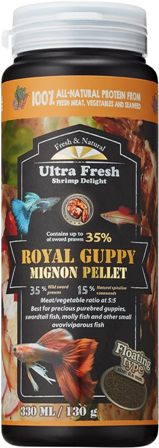
Tap this box to view the current price on Amazon
Guppy Mating and Reproduction
Breeding guppies does not require much thought. It’s enough to place a male and a female together in the tank, and within a short amount of time, you’ll have guppy fry in your aquarium.
Two years after that, you will have a tank filled with so many guppies you can’t put any water in.
There is a reason guppies are called “millions fish” after all.
Choosing mating pairs:
Guppies are not picky about their potential mates. However, if you are interested in breeding them, you’ll have to decide which male and female you will use.
Of note: Guppy females seem to almost be born pregnant. Somewhat of an exaggeration but enough of a concern to put your breeding female in a tank with no males for a few months. This will allow her to run out of sperm so you can start fresh with your male breeder.
First, you want your mating pairs to be healthy. Keeping track of the strongest and healthiest fish will ensure the resulting offspring won’t be susceptible to illness or genetic abnormalities.
You’ll probably want to take into consideration that the colors and patterns of your mating pairs. So if you wish to get a particular color or pattern in the offspring, your best bet is to pair up a male and female that have the desired looks, colors, fin styles, etc.
The best environment for breeding:
As previously mentioned, guppies need little stimulation to breed. However, if you want to increase your chances of success, consider a few issues beforehand.
If you wish to breed specific guppies, it’s best to establish a breeding tank with the selected specimens.
Please note that communal tanks are more affordable and just as effective in getting guppies to breed. However, guppies will breed at random, so you won’t be able to control or predict the patterns and colors of the resulting offspring.
Mating behavior and breeding process:
Male guppies start the mating ritual by flaring and swimming around the female. This behavior is manifested all day long until a female accepts.
Once the female accepts the male’s advances, the male will poke the female’s genital opening for a few seconds with his gonopodium, starting the transfer of sperm to the female. The eggs are fertilized inside the female. Female guppies can store unused sperm for up to three months, allowing her to give birth three times without a male’s help.
To avoid stressing your breeding female, your best bet is to have two breeding females to one male guppy.
Gestation and hatching:
You will know if your female guppy is pregnant by checking her rounded belly for a round circle, called gravid spot. Gestation lasts around 30 days, after which females will give birth to anywhere between 20 and 60 fry.
After birth, the first instinct of the fry is to find shelter and hide, so it’s a good idea to have live plants nearby. This is important if you let your female guppy give birth in a communal tank, as guppy adults and other community fish will try to eat the fry.
You can ensure fry survival by keeping the pregnant female in a breeding tank before she gives birth. After giving birth, move the adult female to a separate tank. Grow the fry in the breeding tank until they reach the juvenile stage.
Guppy fry don’t require any specific care, just provide them with clean water and nutritious food.
Guppies – A final thought.
Guppies are on my list of fish I wouldn’t ever have again. This is because they are so rampant in their reproduction. Once you have guppies, it is really hard to get rid of them. Soon you have too many guppies and things get ugly.
Get a guppy if you wish. A male only tank is a good idea. Never buy female guppies.
Breeding Guppies
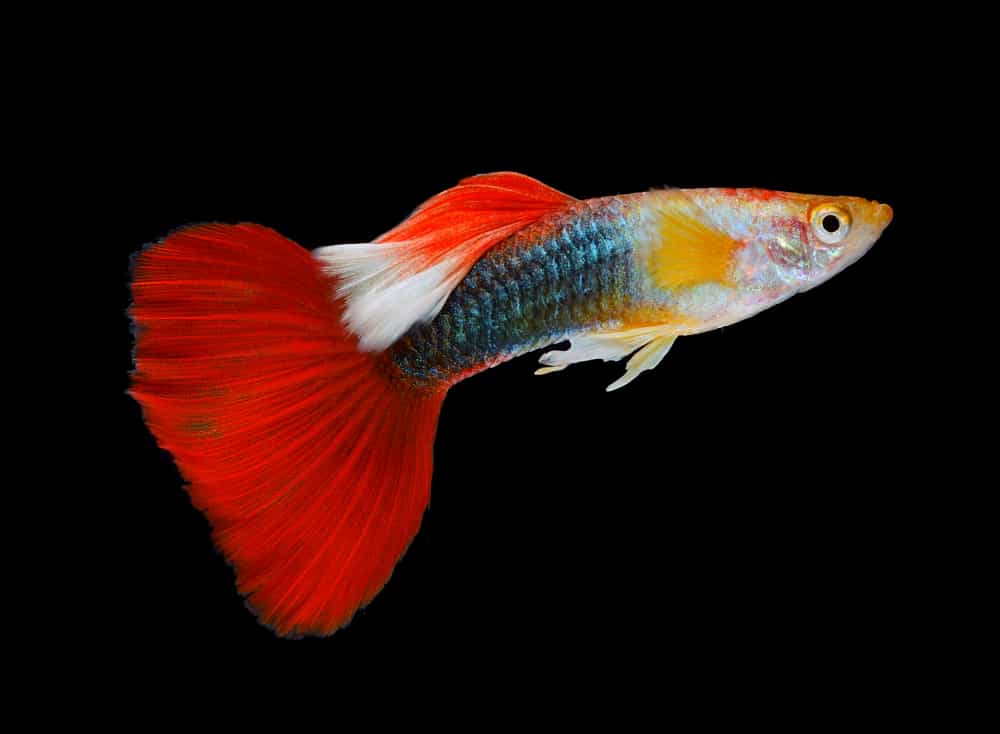

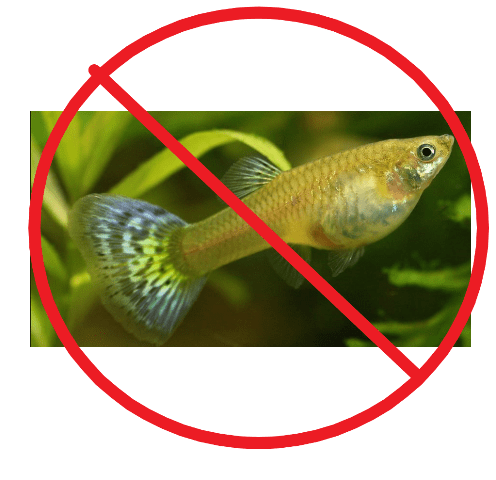
No female Guppies
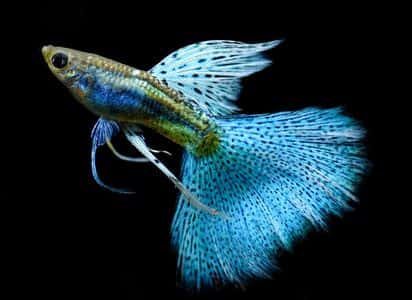
Male Guppies: OK
Guppy Care Part 2
The Guppy is an eye-catching, easy to care for, ornamental fish originally from South and Central America.
Hobbyists have been keeping guppies in aquariums since the early 1900s.
In addition to being attractive, guppies also do an excellent job of controlling water related pests. Guppies have been used to control insects that can carry deadly tropical diseases.
Peaceful and tiny, the male measures up to an inch and a half, while the female can reach up to two and a half inches. Besides size differences, males can have a large colorful tail and more intense body coloration.
Are you captivated by the Guppy’s beauty? Read on…
Guppies Home Turf
One of the most common freshwater aquarium fish is the peaceful, gentle Guppy.
Guppies are native to South and Central America, including Suriname, Antigua, Trinidad, Barbados, Guyana, Venezuela, and Brazil.
Guppies have also been introduced in several regions worldwide. You can now find them anywhere.
A Guppy’s colors and markings vary greatly depending on the variety. Some varieties are yellow, orange, peach, blue, and red, while others are black and yellow.
Habitat
In nature, Guppies live in streams, lakes, and ponds. The majority of Guppies prefer freshwater, but there are also plenty that live in brackish (slightly salty) water.
It is common to find large schools of Guppies residing among dense aquatic plants. This helps protect them from predators.
Insect Larvae? Yuck. (What to Feed Your Guppies.)
Aside from insect larvae, Guppies eat a variety of organic matter, such as algae, invertebrates, and other types of organisms.
These fish consume many different kinds of food in an aquarium. Adding high-quality commercial flake and tablet food in addition to live or frozen foods such as bloodworms, brine shrimp, or daphnia will make these fish more colorful and their behavior more natural.
Of course you can always grow your own live foods:
What Are Guppies Like? (Behavior)
Hobbyists consider Guppies a very peaceful fish that are quite sociable.
Despite the Guppy’s peaceful nature, the males can fight among each other when they are trying to mate with the females. Their constant persistence on breeding with females is the reason for this. Because of this, it’s wise to keep three females to each male when stocking your aquarium.
Male-only aquariums are not recommended, as male fish can become quite aggressive towards one another, causing damage to their fins and causing stress to individuals.
An all-female tank is an interesting option, as they rarely fight with each other. When you buy females, they almost always come pregnant, so it won’t be all females for long.
This file was first published in a Public Library of Science journal. PLOS Journal link.
How to deal with an aggressive guppy
(Really? An aggressive guppy?? Oh come on…)
Have you ever heard of the Thailand Fighting Guppy? No? That’s because they’re not real. But, every once in a while you’ll get a male guppy that “Breaks Bad.” The “Walter White” of guppies.
An unusually aggressive Guppy will nip other small fish and chase after them. This guppy is saying, like Walter once said, “Stay out of my territory!”
(You know the article is going downhill fast when guppies are compared to Walter White.)
Managing symptoms of aggressive behavior is easy, with a little knowledge of feeding Guppies.
A healthy guppy is always interested in food. Because of this, you can expect guppies to protect areas where food is most plentiful. Pay attention to where the extra pieces land in the aquarium. Usually, there will be more signs of Guppy aggression in this region.
To manage aggression, change the fish’s feeding schedule, offer small portions of food several times a day, and in different places in the aquarium.
Adding more females to increase the male-to-female ratio goes a long way toward decreasing male-to-male aggression; that’s because they will end up paying more attention to the females. You can also separate the males by placing them in their own aquarium, so that they each have their own space and their own females to mate with.
Are guppies compatible with other fish?
Except for the occasional “The Walter White Guppy,” guppies are pretty friendly with his tank mates.
Of course a fish this size can become a tasty meal for larger species.
When keeping guppies in a community tank, opt for similarly sized, non-aggressive tank mates who will not compete for food.
Guppies like to swim close to the surface of the aquarium. When choosing tank mates, consider adding fish that swim in the middle and bottom regions. By doing this, you will give the guppies more room and you will keep all the zones of your aquarium filled.
Finally, don’t forget that the Guppy is a social fish. They like to live in the company of others of their kind. Therefore, keeping them in a group with males and females is the best option to keep them healthy and happy.
Conclusion
Guppies are a very charming little fish and are ideal for beginners. Many aquarists are fans of this species because of the color and movement in the environment. For those setting up their first aquarium, it is worth including some Guppies to get started.
Guppy care sheet:
Common name: Guppy
Order: Cyprinodontiformes — Family: Poeciliidae
Distribution: South America, Venezuela, Barbados, Trinidad, northern Brazil, and Guyanas. Widely introduced and established in many countries.
Behavior: Peaceful, communal
Adult Size: 1.5 inches (male) to 2.5 inches (female)
Life Expectancy: 3 years
pH: 7.0 to 8.5
Water Hardness: indifferent
Temperature: 74° to 78° F (23° to 26°C)
Minimum aquarium: 10 gallons for a trio.
Feeding: Omnivorous, will readily accept dry and live food.
Reproduction: Viviparous, internal fertilization.
Other pages on this site:
* Freshwater Aquarium Plants You Can Grow
* 11 Exquisite, Effortless Aquarium Plants That Totally Won't Outgrow Your Tiny Fish Tank
* Discus Fish: Because Regular Fish Just Aren't Enough of a Challenge
* Planted Nano Aquarium Magic: Tricking Your Plants Into Thinking They're Happy (CO2-Free Method)
* How to Train Your Oscars: Because Fish Totally Respond to Commands Like Dogs
* What size aquarium should you get?
Guppy care – 21 pictures, a bonus article, & a guppy care print out
You can turn your aquarium fish hobby into an income producing side hustle.
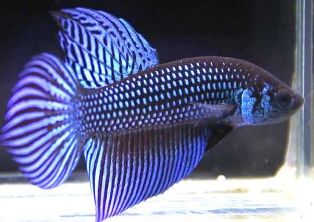
Create a website like mine to earn enough to buy aquariums, or fish, or equipment or if you work hard enough, retire from your 9 to 5.
I used "Divi" website creator to make this website. It costs $89/year (this comes out to about $7/month.)
Tap this ad to find out more.
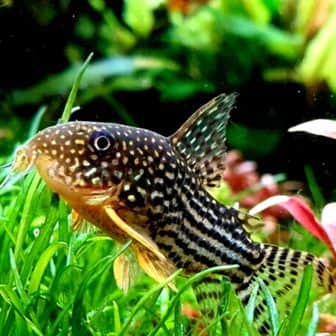
Keeping fish can be costly, but there's a great way to offset those expenses.
Consider creating your own income producing website, just like I did with this one! I advertise Divi website creator, but you could place other ads on your website.
I've used Divi Wordpress website builder to build this site, and it's incredibly user-friendly. With its drag-and-drop interface, creating your own website becomes a breeze.
Simply tap this box to get started and see how easy it is to create a website with Divi.
The cost is $89/year. This is $7.41 per month. Divi comes with a 30 money-back guarantee. Try it at no risk.
Take this box to visit the Divi website to learn more. The link opens in a new window.

* Great Video: How to make a Website | Divi Tutorial 2024
Guppy Grass For Sale
Live plant that provides a place for baby guppies to hide.

Tap this box to check the current Amazon price.
Guppy Food:
“Ultra Fresh Royal Guppy Mignon Pellets”
Made with actual fish food like shrimp, prawns and seaweed.
If you are looking for fish food that is made with chemicals like A-tocopherol-Acetate, FD& C blue, or Mendone sodium bisulfit complex, don’t buy this food.

Tap this box to view the current price on Amazon
